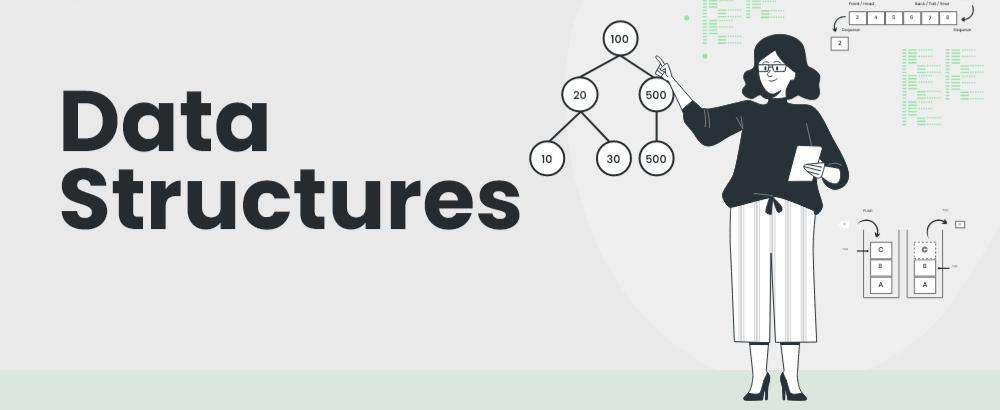
Welcome to our in-depth tutorial on data structures! Whether you’re a budding programmer or a seasoned developer looking to refresh your knowledge, understanding data structures is crucial for efficient problem-solving and algorithm design. In this guide, we’ll explore the fundamental concepts of data structures, their types, and practical applications.
Understanding Data Structures
At its core, a data structure is a particular way of organizing and storing data in a computer so that it can be accessed and modified efficiently. The right data structure can dramatically improve the performance of an algorithm and is key to writing code that scales well with increasing data size.
Types of Data Structures
- Arrays: The simplest and most widely used data structure, an array is a collection of elements, each identified by an index or key.
- Linked Lists: A sequence of nodes where each node contains data and a reference to the next node in the sequence.
- Stacks: A collection of elements that follows the Last In, First Out (LIFO) principle.
- Queues: Similar to stacks, queues follow the First In, First Out (FIFO) principle.
- Trees: A hierarchical structure consisting of nodes, with a single node known as the root, from which a set of nodes descend.
- Graphs: A collection of nodes connected by edges, useful for representing relationships.
Choosing the Right Data Structure
Selecting the appropriate data structure depends on the scenario and the operations you need to perform. For instance, if you need quick access to elements by index, arrays might be the best choice. If you need to frequently add and remove elements, a linked list could be more suitable.
Practical Applications
Data structures are everywhere in software development. They are used in databases to store data, in web browsers to manage tabs, and in almost every software application you can think of.
The Complete Data Structures Tutorial
1. Introduction to Data Structures:
- What is Data Structure: Types, Classifications and Applications
- Introduction to Data Structures
- Common operations on various Data Structures
2. Popular types of Data Structures:
- Array
- Linked List
- Stack
- Queue
- Binary Tree
- Binary Search Tree
- Heap
- Hashing
- Graph
- Matrix
- Misc
- Advanced Data Structure
3. Overview:
- Introduction to Linear Data Structures
- Introduction to Hierarchical Data Structure
- Overview of Data Structures | Set 3 (Graph, Trie, Segment Tree and Suffix Tree)
- Abstract Data Types
4. Array:
- Search, insert and delete in an unsorted array
- Search, insert and delete in a sorted array
- Write a program to reverse an array
- Leaders in an array
- Given an array A[] and a number x, check for pair in A[] with sum as x
- Majority Element
- Find the Number Occurring Odd Number of Times
- Largest Sum Contiguous Subarray
- Find the Missing Number
- Search an element in a sorted and pivoted array
- Merge an array of size n into another array of size m+n
- Median of two sorted arrays
- Program for array rotation
- Reversal algorithm for array rotation
- Block swap algorithm for array rotation
- Maximum sum such that no two elements are adjacent
- Sort elements by frequency | Set 1
- Count Inversions in an array
All Articles on Array
Coding Practice on Array
Quiz on Array
Coding Practice on Array
Recent Articles on Array
5. Matrix:
- Search in a row wise and column wise sorted matrix
- Print a given matrix in spiral form
- A Boolean Matrix Question
- Print unique rows in a given boolean matrix
- Maximum size square sub-matrix with all 1s
- Print unique rows in a given boolean matrix
- Inplace M x N size matrix transpose | Updated
- Dynamic Programming | Set 27 (Maximum sum rectangle in a 2D matrix)
- Strassen’s Matrix Multiplication
- Create a matrix with alternating rectangles of O and X
- Print all elements in sorted order from row and column wise sorted matrix
- Given an n x n square matrix, find sum of all sub-squares of size k x k
- Count number of islands where every island is row-wise and column-wise separated
- Find a common element in all rows of a given row-wise sorted matrix
All Articles on Matrix
- Coding Practice on Matrix
- Recent Articles on Matrix.
6. Linked List:
¡》Singly Linked List:
- Introduction to Linked List
- Linked List vs Array
- Linked List Insertion
- Linked List Deletion (Deleting a given key)
- Linked List Deletion (Deleting a key at given position)
- A Programmer’s approach of looking at Array vs. Linked List
- Find Length of a Linked List (Iterative and Recursive)
- How to write C functions that modify head pointer of a Linked List?
- Swap nodes in a linked list without swapping data
- Reverse a linked list
- Merge two sorted linked lists
- Merge Sort for Linked Lists
- Reverse a Linked List in groups of given size
- Detect and Remove Loop in a Linked List
- Add two numbers represented by linked lists | Set 1
- Rotate a Linked List
- Generic Linked List in C
¡¡》Circular Linked List:
- Circular Linked List Introduction and Applications,
- Circular Singly Linked List Insertion
- Circular Linked List Traversal
- Split a Circular Linked List into two halves
- Sorted insert for circular linked list
¡¡¡》Doubly Linked List:
- Doubly Linked List Introduction and Insertion
- Delete a node in a Doubly Linked List
- Reverse a Doubly Linked List
- The Great Tree-List Recursion Problem.
- QuickSort on Doubly Linked List
- Merge Sort for Doubly Linked List
All Articles of Linked List
- Coding Practice on Linked List
- Recent Articles on Linked List
7. Stack:
- Introduction to Stack
- Infix to Postfix Conversion using Stack
- Evaluation of Postfix Expression
- Reverse a String using Stack
- Implement two stacks in an array
- Check for balanced parentheses in an expression
- Next Greater Element
- Reverse a stack using recursion
- Sort a stack using recursion
- The Stock Span Problem
- Design and Implement Special Stack Data Structure
- Implement Stack using Queues
- Design a stack with operations on middle element
- How to efficiently implement k stacks in a single array?
- Sort a stack using recursion
All Articles on Stack
- Coding Practice on Stack
- Recent Articles on Stack
8. Queue:
- Queue Introduction and Array Implementation
- Linked List Implementation of Queue
- Applications of Queue Data Structure
- Priority Queue Introduction
- Deque (Introduction and Applications)
- Implementation of Deque using circular array
- Implement Queue using Stacks
- Find the first circular tour that visits all petrol pumps
- Maximum of all subarrays of size k
- An Interesting Method to Generate Binary Numbers from 1 to n
- How to efficiently implement k Queues in a single array?
All Articles on Queue
- Coding Practice on Queue
- Recent Articles on Queue
9. Binary Tree:
- Binary Tree Introduction
- Binary Tree Properties
- Types of Binary Tree
- Handshaking Lemma and Interesting Tree Properties
- Enumeration of Binary Tree
- Applications of tree data structure
- Tree Traversals
- BFS vs DFS for Binary Tree
- Level Order Tree Traversal
- Diameter of a Binary Tree
- Inorder Tree Traversal without Recursion
- Inorder Tree Traversal without recursion and without stack!
- Threaded Binary Tree
- Maximum Depth or Height of a Tree
- If you are given two traversal sequences, can you construct the binary tree?
- Clone a Binary Tree with Random Pointers
- Construct Tree from given Inorder and Preorder traversals
- Maximum width of a binary tree
- Print nodes at k distance from root
- Print Ancestors of a given node in Binary Tree
- Check if a binary tree is subtree of another binary tree
- Connect nodes at same level
All articles on Binary Tree
- Coding Practice on Binary Tree
- Recent Articles on Tree
10. Binary Search Tree:
- Search and Insert in BST
- Deletion from BST
- Minimum value in a Binary Search Tree
- Inorder predecessor and successor for a given key in BST
- Check if a binary tree is BST or not
- Lowest Common Ancestor in a Binary Search Tree.
- Inorder Successor in Binary Search Tree
- Find k-th smallest element in BST (Order Statistics in BST)
- Merge two BSTs with limited extra space
- Two nodes of a BST are swapped, correct the BST
- Floor and Ceil from a BST
- In-place conversion of Sorted DLL to Balanced BST
- Find a pair with given sum in a Balanced BST
- Total number of possible Binary Search Trees with n keys
- Merge Two Balanced Binary Search Trees
- Binary Tree to Binary Search Tree Conversion
All Articles on Binary Search Tree
- Coding Practice on Binary Search Tree
- Recent Articles on BST
11. Heap:
- Binary Heap
- Why is Binary Heap Preferred over BST for Priority Queue?
- Heap Sort
- K’th Largest Element in an array
- Sort an almost sorted array
- Binomial Heap
- Fibonacci Heap
- Tournament Tree (Winner Tree) and Binary Heap
All Articles on Heap
- Coding Practice on Heap
- Recent Articles on Heap
12. Hashing:
- Hashing Introduction
- Separate Chaining for Collision Handling
- Open Addressing for Collision Handling
- Print a Binary Tree in Vertical Order
- Find whether an array is subset of another array
- Union and Intersection of two Linked Lists
- Find a pair with given sum
- Check if a given array contains duplicate elements within k distance from each other
- Find Itinerary from a given list of tickets
- Find number of Employees Under every Employee
All Articles on Hashing
- Coding Practice on Hashing
- Recent Articles on Hashing
13. Graph:
¡》Introduction, DFS and BFS:
- Graph and its representations
- Breadth First Traversal for a Graph
- Depth First Traversal for a Graph
- Applications of Depth First Search
- Applications of Breadth First Traversal
- Detect Cycle in a Directed Graph
- Detect Cycle in Graph using DSU
- Detect cycle in an Undirected Graph using DFS
- Longest Path in a Directed Acyclic Graph
- Topological Sorting
- Check whether a given graph is Bipartite or not
- Snake and Ladder Problem
- Minimize Cash Flow among a given set of friends who have borrowed money from each other
- Boggle (Find all possible words in a board of characters)
- Assign directions to edges so that the directed graph remains acyclic
All Articles on Graph Data Structure
- Coding Practice on Graph
- Recent Articles on Graph
14. Advanced Data Structure:
¡》Advanced Lists:
- Memory efficient doubly linked list
- XOR Linked List – A Memory Efficient Doubly Linked List | Set 1
- XOR Linked List – A Memory Efficient Doubly Linked List | Set 2
- Skip List | Set 1 (Introduction)
- Self Organizing List | Set 1 (Introduction)
- Unrolled Linked List | Set 1 (Introduction)
¡¡》Segment Tree:
- Segment Tree | Set 1 (Sum of given range)
- Segment Tree | Set 2 (Range Minimum Query)
- Lazy Propagation in Segment Tree
- Persistent Segment Tree | Set 1 (Introduction)
All articles on Segment Tree
¡¡¡》Trie:
- Trie | (Insert and Search)
- Trie | (Delete)
- Longest prefix matching – A Trie based solution in Java
- Print unique rows in a given boolean matrix
- How to Implement Reverse DNS Look Up Cache?
- How to Implement Forward DNS Look Up Cache?
All Articles on Trie
¡V》Binary Indexed Tree:
- Binary Indexed Tree
- Two Dimensional Binary Indexed Tree or Fenwick Tree
- Binary Indexed Tree : Range Updates and Point Queries
- Binary Indexed Tree : Range Update and Range Queries
All Articles on Binary Indexed Tree
V》Suffix Array and Suffix Tree:
- Suffix Array Introduction
- Suffix Array nLogn Algorithm
- Kasai’s Algorithm for Construction of LCP array from Suffix Array
- Suffix Tree Introduction
- Ukkonen’s Suffix Tree Construction – Part 1
- Ukkonen’s Suffix Tree Construction – Part 2
- Ukkonen’s Suffix Tree Construction – Part 3
- Ukkonen’s Suffix Tree Construction – Part 4,
- Ukkonen’s Suffix Tree Construction – Part 5
- Ukkonen’s Suffix Tree Construction – Part 6
- Generalized Suffix Tree
- Build Linear Time Suffix Array using Suffix Tree
- Substring Check
- Searching All Patterns
- Longest Repeated Substring,
- Longest Common Substring, Longest Palindromic Substring
All Articles on Suffix Tree
V¡》AVL Tree:
- AVL Tree | Set 1 (Insertion)
- AVL Tree | Set 2 (Deletion)
- AVL with duplicate keys
V¡¡》Splay Tree:
- Splay Tree | Set 1 (Search)
- Splay Tree | Set 2 (Insert)
V¡¡¡》B Tree:
- B-Tree | Set 1 (Introduction)
- B-Tree | Set 2 (Insert)
- B-Tree | Set 3 (Delete)
X》Red-Black Tree:
- Red-Black Tree Introduction
- Red Black Tree Insertion.
- Red-Black Tree Deletion
- Program for Red Black Tree Insertion
All Articles on Self-Balancing BSTs
X¡》K Dimensional Tree:
- KD Tree (Search and Insert)
- K D Tree (Find Minimum)
- K D Tree (Delete)
15. Others:
- Treap (A Randomized Binary Search Tree)
- Ternary Search Tree
- Interval Tree
- Implement LRU Cache
- Sort numbers stored on different machines
- Find the k most frequent words from a file
- Given a sequence of words, print all anagrams together
- Tournament Tree (Winner Tree) and Binary Heap
- Decision Trees – Fake (Counterfeit) Coin Puzzle (12 Coin Puzzle)
- Spaghetti Stack
- Data Structure for Dictionary and Spell Checker?
- Cartesian Tree
- Cartesian Tree Sorting
- Sparse Set
- Centroid Decomposition of Tree
- Gomory-Hu Tree
Recent Articles on Advanced Data Structures.
16. Miscellaneous
- Commonly Asked Data Structure Interview Questions | Set 1
- A data structure for n elements and O(1) operations
- Expression Tree
These articles provide a complete learning path of Data Structure. So practiceand be a pro in data structure.
Conclusion
Mastering data structures is a journey that will pay dividends throughout your coding career. By understanding the strengths and limitations of each type, you can choose the most effective one for your projects, leading to faster and more reliable software.
Remember, the key to learning data structures is practice. Implement them, play with them, and you’ll gain a deeper understanding of their workings and nuances.
RELATED ARTICLES
- Algorithms in DSA Tutorial & Learning Path: Unlocking the Power of Efficient Problem-Solving
- Common Data Structure Interview Questions & Answers
- Frequently Asked Questions on Algorithms in Interviews and Answers
- 100 Best Data Structure and Algorithms (DSA) Interview Questions: Your Ultimate Prep Guide









